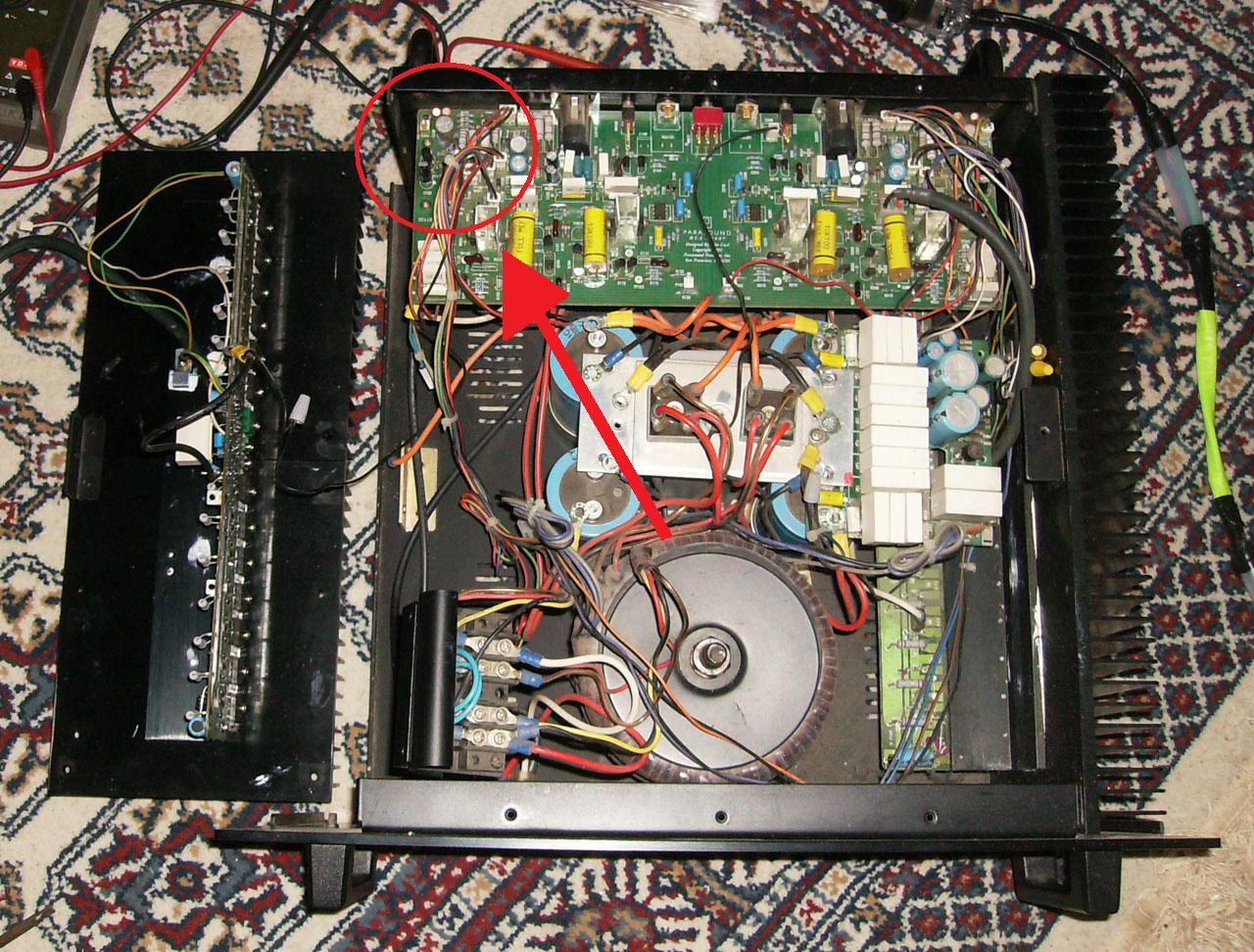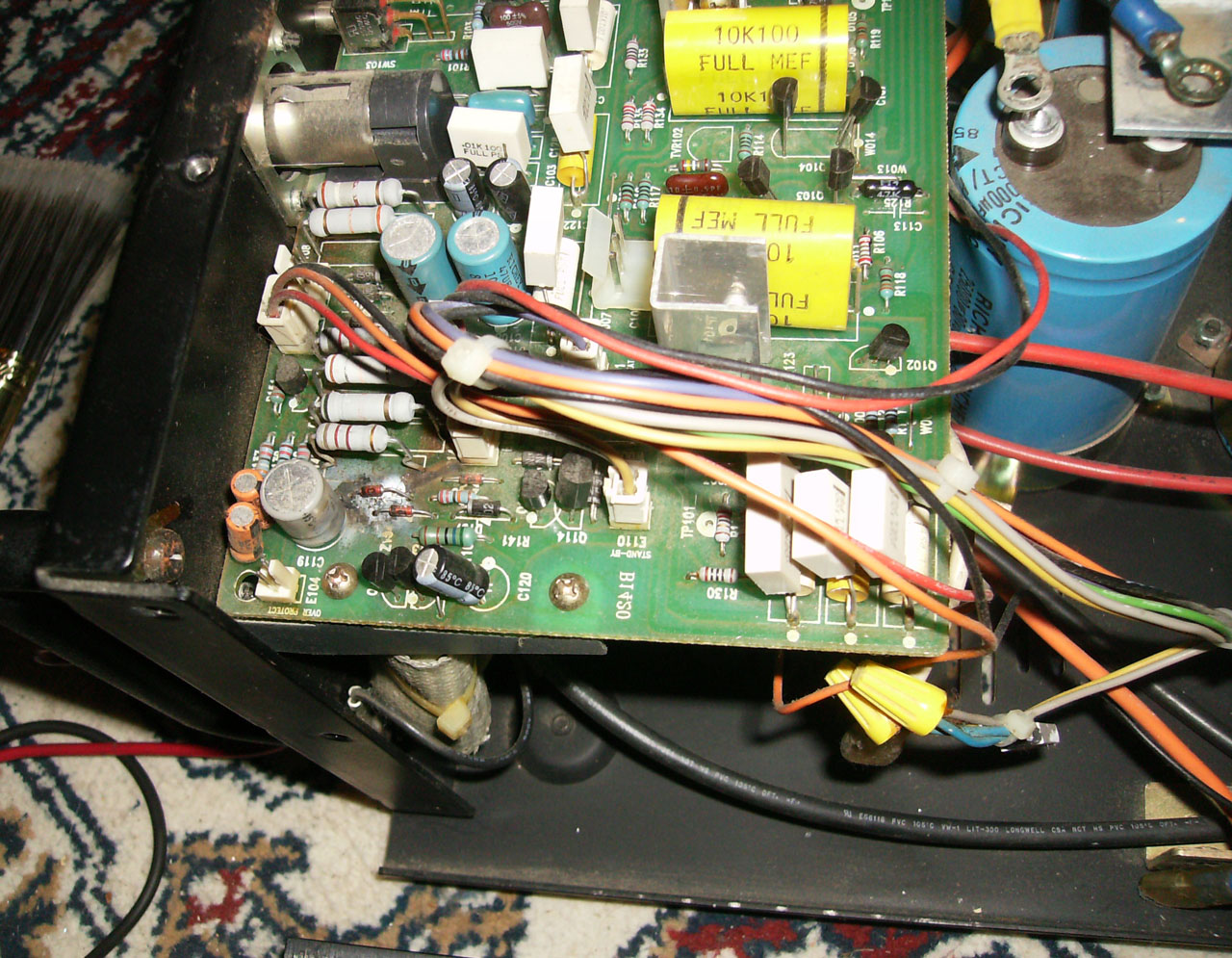I’ve had a trusty old Parasound HCA2200 II since the dawn of time (my first hi-end amp). Over the last few years It’s been getting harder for it to start. As in, if it’s turned on often the left channel would not work until it had warmed up then powercycled a few times. My solution: leave it on (doubles as a great space heater). A few weeks ago I was listening at a moderate volume and suddenly the left channel dropped in output and sounds like a clipping headphone from 10 feet away.
I’m really new to this – don’t even know if I have the right terms for things but I would like to give a shot at fixing it myself. I’ve been looking around online for what to look at but have come up with mostly check the fuses and car amp stuff. I have an old tone generator and oscilloscope but have little idea how to use or interpret it. With a multimeter here is what I have learned so far:
When powered on:
There is no dc in the outputs (if there is it’s below the threshold of my meter)
The working rightside reads 72.5v for b+ and b–
The leftside reads 75.7 for b+ and b–
After being powered down and unplugged all except the B+ capacitor for the left channel discharge within minutes, I came back a few hours later and the b+ line had gone from 72v (measured when the rest were already discharged) to -16. I don't even get how this is possible.
Resistance: It’s a dual mono design, I measured these where the caps screw into the L and R power supply boards
L R
b- to b+ open 10.79M
b- to b- open -3.1M
b+ to ground open -2.8M
b- to ground -1.7M -1.4M
About 5 years ago I took the amp apart for cleaning and noticed there is char under some of the ceramic resistors on the left power supply board, as it never effected operation I never paid it any attention assuming it was a lack of cleanup from a previous repair (I bought it used with new transformers). I tried to measure the resistance of the resistors but most of that circuit board is 3 big traces, the meter starts at about 1M and within a few seconds rises to the 10M limit of my meter.
Hopefully someone out there can call this one, I am very new to this and can see from the numbers there is something wrong, however I have no idea what to do next. Any input appreciated.
I’m really new to this – don’t even know if I have the right terms for things but I would like to give a shot at fixing it myself. I’ve been looking around online for what to look at but have come up with mostly check the fuses and car amp stuff. I have an old tone generator and oscilloscope but have little idea how to use or interpret it. With a multimeter here is what I have learned so far:
When powered on:
There is no dc in the outputs (if there is it’s below the threshold of my meter)
The working rightside reads 72.5v for b+ and b–
The leftside reads 75.7 for b+ and b–
After being powered down and unplugged all except the B+ capacitor for the left channel discharge within minutes, I came back a few hours later and the b+ line had gone from 72v (measured when the rest were already discharged) to -16. I don't even get how this is possible.
Resistance: It’s a dual mono design, I measured these where the caps screw into the L and R power supply boards
L R
b- to b+ open 10.79M
b- to b- open -3.1M
b+ to ground open -2.8M
b- to ground -1.7M -1.4M
About 5 years ago I took the amp apart for cleaning and noticed there is char under some of the ceramic resistors on the left power supply board, as it never effected operation I never paid it any attention assuming it was a lack of cleanup from a previous repair (I bought it used with new transformers). I tried to measure the resistance of the resistors but most of that circuit board is 3 big traces, the meter starts at about 1M and within a few seconds rises to the 10M limit of my meter.
Hopefully someone out there can call this one, I am very new to this and can see from the numbers there is something wrong, however I have no idea what to do next. Any input appreciated.
Does it have speaker relays for delayed turn on and protection? If so, it sure sounds like a bad relay contact in the bad channel. It if does have relays, try tapping on the relays when it's acting up. If that doesn't change things, see if you can pop the cover of the bad channel relay and wiggle the contacts when it's not working properly. It will be obvious if the relay contacts are to blame. If the cover won't come off easily then, worst case, temporarily jumper around the relay contacts but make sure you get the right contacts on the PCB.
If it does NOT have speaker relays, or you can rule out the relays, then update the thread and we can go from there. But it sounds like a relay problem which is an easy fix (new relays).
If it does NOT have speaker relays, or you can rule out the relays, then update the thread and we can go from there. But it sounds like a relay problem which is an easy fix (new relays).
I hear them both clicking on, the left channel one takes longer to click off when the amp is turned off (they used to click off at near the same time) but they both sound like they are working - I will verify with a meter as soon as I mark the million connections this thing has to the main board so I can remove it and get to them below. Also no protection lights are on.
I tore into the thing a bit more and found some new burnt circuit board - yay! I assume the white goo leaked out from the cap.
Unfortunately I have no idea what this part / section does.


I tore into the thing a bit more and found some new burnt circuit board - yay! I assume the white goo leaked out from the cap.
Unfortunately I have no idea what this part / section does.


John Curl (who may have designed your amp) provided an email to Tony at Parasound above and that seems worth pursuing. Just because the relays click doesn't mean the contacts are OK.
I'm not sure what's going on with the toasted PCB bits. But if the amp is working fine sometimes, it must not be anything too serious. But you can email your pics and symptoms to Parasound and hopefully they can offer you better advice than most of us can here on DIYA. I know they stand behind their products and are known for great customer service.
I'm not sure what's going on with the toasted PCB bits. But if the amp is working fine sometimes, it must not be anything too serious. But you can email your pics and symptoms to Parasound and hopefully they can offer you better advice than most of us can here on DIYA. I know they stand behind their products and are known for great customer service.
Yes absolutely. I have not posted here much so I am still under moderation. My post with the pics was sent long before John commented, and yes "Designed by John Curl" is hard to miss.
I about fell out of my chair! I don't know if it's life with me being run without the top cover and dramatically hooked to a 240v dryer plug would be approved, but it doubles as a great trap for the person (like me) who can't stop starring inside it. It’s even infected a few buddies of mine with the audio bug.
An email to Tony has been sent.
I about fell out of my chair! I don't know if it's life with me being run without the top cover and dramatically hooked to a 240v dryer plug would be approved, but it doubles as a great trap for the person (like me) who can't stop starring inside it. It’s even infected a few buddies of mine with the audio bug.
An email to Tony has been sent.
Hi to all, I have the same problem with the photos above, any idea what is causing it, do you think is possible to send the board to parasound for a full refurbish ??
Sorry for posting again for the same question, but I have replaced all the electrolytic capacitors, the resistors are getting scorching hot you can burn your finger, is it normal ? is there anything we can do to avoid the heat ?
Thanks and Rgards
Thanks and Rgards
An externally hosted image should be here but it was not working when we last tested it.
Well at least you gave it a few years, don't think you need to apologize for asking again!
That's a nice amplifier, hope you can get it sorted out, is it functioning fine? Is the bias holding stable?
That's a nice amplifier, hope you can get it sorted out, is it functioning fine? Is the bias holding stable?
Yes, everything is working fine, it was playing for 10 hours yesterday in order to burn in the caps, the bias is stable at 20mV.
- Status
- Not open for further replies.
- Home
- Amplifiers
- Solid State
- distortion in trusy old Parasound amp - newbie repair help